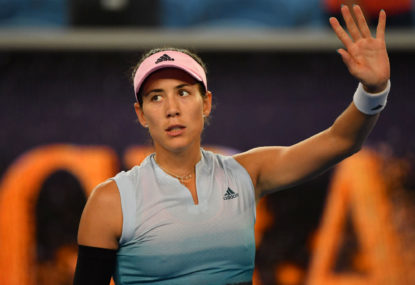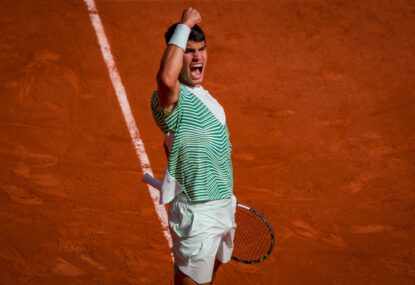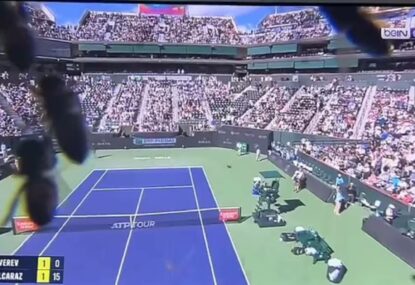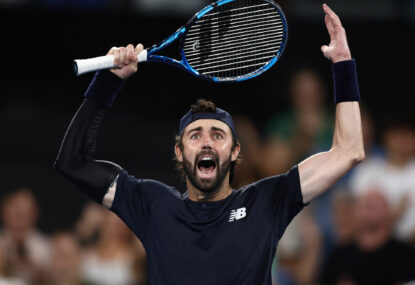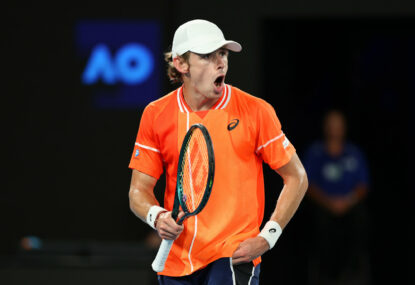Ancient records tell us that the most famous form of bullfighting is the Spanish-style bullfighting.
The Spaniards love aggression and this trait is seen evidently by the sports which are popular in Spain. Last century saw the rise of Spain as a football-loving nation. Spanish football fans are amongst the most dedicated and fervent in Europe and are matched in their fanaticism only by the Italians.
Long regarded as an elite sport in Spain, tennis, along with most other racquet sports, has taken a little longer to attract Spaniards to jump on the bandwagon. Tennis is a contrasting sport as compared to football and bullfighting. Tennis is a sport where a tennis player keeps on talking to themselves.
In other sports wrestlers, golfers, goalkeepers, they mutter to themselves, of course, but tennis players talk to themselves – and answer. In the heat of a match, tennis players look like lunatics in a public square, ranting and swearing and conducting the Lincoln-Douglas debate with their alter egos.
Why? Because tennis is so damned lonely. Only boxers understand the loneliness of a tennis player – and yet boxers have their opponent to touch to and corner men and managers to chat. In tennis you stand lonely face-to-face with the enemy, trade blows with him, but never touch or talk to him, or anyone else.
Tennis started gaining some ground in Spain owing to Grand Slam victories of players like Conchita Martinez, Sergi Bruguera, Carlos Moya, Arantxa Sanchez Vicario and Juan Carlos Ferrero.
However, the shore of Spain was waiting for some tennis tsunami to hit it, and hit it hard. The blow came from a Mallorcan (resident of Mallorca); an island east of Spain in the Mediterranean and the name of this gladiator was Rafael Nadal Parera.
Rafael Nadal was born in Manacor, a town on the island of Mallorca to parents Ana María Parera and Sebastián Nadal. His father is a businessman. His uncle, Miguel Ángel Nadal, is a retired professional footballer, who played for FC Barcelona and also the Spanish national team.
Recognizing in Rafael a natural athleticism, another uncle and now his longtime coach Toni Nadal, a former professional tennis player, introduced him to tennis when he was three years old. At age eight, Nadal won an under-12 regional tennis championship and this made Toni Nadal intensify his training, and at that time he encouraged Nadal to play left-handed for a natural advantage on the tennis court, as he noticed Nadal played his trademark backhand erstwhile forehand shots with two hands.
At age 12, Nadal won the Spanish and European tennis titles in his age group. To capitalize on this young tennis prodigy, Spanish tennis federation invited Nadal to leave Mallorca and move to Barcelona to continue his tennis training. His family turned down this request, partly because they feared his education would suffer, but also because Toni thought that he was the best person who would keep Rafael out of his comfort zone, grate on his nerves and simultaneously conspire to keep him grounded so that success didn’t go in his head.
Toni, as a coach, was completely dedicated. He improved young Nadal’s technique, physical prowess and mental aptitude for tennis. He made the young boy set a benchmark of endurance that has served him as an example and as a reminder even today that if he wants something badly enough, no sacrifice is too great.
The under-14 Spanish national championship win was a testimony to this fact. Nadal played the entire tournament with a broken little finger. Under Toni’s vigilant eye’s, he refused to pull out or even complain about it to anyone. He won the final match 6-4 in the third set by gripping the racquet with four fingers, the broken one dangling lifelessly.
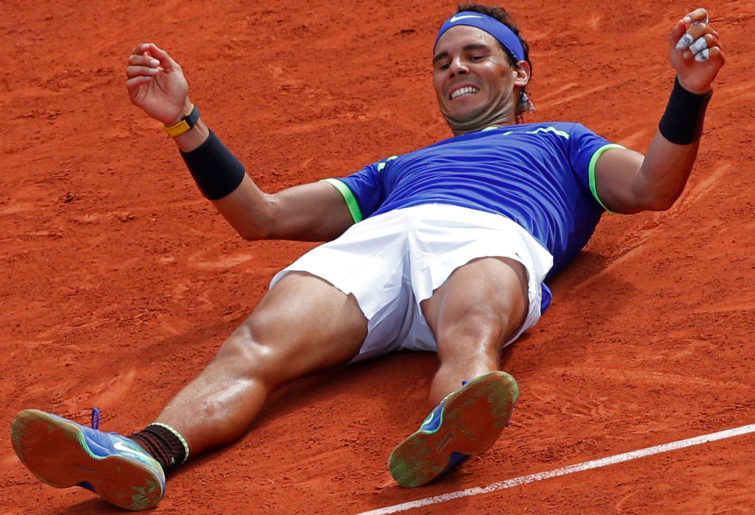
(AP Photo/Christophe Ena)
Thus began the journey of this prince who ventured off in his early teens to conquer the tennis world. Little did anyone know, he would metamorphose into an emperor, a most decorated one, displaying his spectacular skills around the globe. In 2002, aged 16, Nadal reached the semifinals of the Boys’ Singles tournament at Wimbledon, in his first ITF junior event.
In the same year, he helped Spain defeat the US in the final of the Junior Davis Cup. He won the ATP Newcomer of the Year Award. In his Wimbledon debut in 2003, he became the youngest man to reach the third round since Boris Becker in 1984. Nadal, at 18 years and six months, became the youngest player to register a singles victory in a Davis Cup final for a winning nation by beating the then world No. 2, Andy Roddick.
He helped Spain clinch the 2004 title over the United States in a 3–2 win.
The real test of a sportsperson is not how well he plays the role he has invented for himself, but how well he plays the role that destiny has assigned to him, and in tennis, destiny selects only a few to enthrone the four coveted seats of diety,the Grand Slams. The Spaniard now targeted grand slams in his list of conquest and he drew the first blood in 2005.
Nadal (aged 19) defeated Mariano Puerta in the final, becoming the second male player, after Mats Wilander in 1982, to win the French Open on his first attempt. He was the first teenager to win a Grand Slam singles title since Pete Sampras won the 1990 US Open at age 19. Winning improved his world ranking to No. 3.
Thus, Nadal’s first date with Philippe-Chatrier tennis court at the venue Roland-Garros later blossomed into a long-lasting relationship. His adroitness and dexterity with the tennis racquet matched with fearlessness on these courts left the world flabbergasted. As the Pied Piper made the city of Hamlin free from rats by making them dance on his tunes, Nadal’s fans in Paris were mesmerized by the song which the strings of his racquet produced.
The balls rolled and danced, and so did the red clay. Today he is known as the “King of Clay,” and Rafael Nadal has dominated the French Open ever since his first tournament in 2005. The Spaniard’s reign on the clay of Roland Garros has been unprecedented and has been one of the magical things in tennis history.
The mind-boggling stats have only got wilder from there.
This year; Nadal dropped just one set in the entire tournament. That’s the sixth time in 14 French Opens he’s played that he’s lost one or fewer sets. On three occasions Nadal won Roland Garros without losing a set (2008, 2010, and 2017). His career record at Roland Garros might be the most staggering number of all.
Since his first French Open appearance in 2005, Nadal has a win-loss record of 86-2 with one withdrawal. That’s two losses (Soldering 2009, Djokovic 2015) in 14 years. That record gives him a winning percentage of 97.7 in Paris. The next closest mark for any men’s player at a single tournament is Björn Borg who went 51-4 at Wimbledon with a 92.7 win percentage.
Nadal has a total of 11 (La Undécima) French Open titles in his bag and the wildest part of it all is that, even at 32, it doesn’t look like Nadal will be slowing down at Roland Garros anytime soon.

. (Mike Egerton/PA via AP)
Nadal’s playing style and personality was summarized by Connors.
He said, “I think tennis has waited quite some time for a kid like this. Nadal is going to die for every point. He’s willing to leave his blood out there.”
His aggressive nature in his office (tennis court), a behind-the-baseline game founded on heavy topspin groundstrokes, consistency, speedy footwork and exemplary court coverage makes him an indomitable counterpuncher. Known for his athleticism and speed around the court, Nadal is an excellent defender who hits well on the run, constructing winning plays from seemingly defensive positions. He also plays very fine drop shots, which work especially well because his heavy topspin often forces opponents to the back of the court.
His evolution into an all-court champion has established him as one of the best players of all time. His record of two career Golden Slams (won all four majors along with Olympic Gold medal in singles), 17 Grand slam titles(11 French Open, two Wimbledon, one Australian Open and 3 US Open), 11 Monte-Carlo Masters, 11 Barcelona Open, five Madrid Open and eight Rome Masters authenticates his all-around performance.
This has made Nadal’s trophy room huge….smaller only to the one which his peer, foe, challenger and a resolute opponent Roger Federer owes. Federer (winner of highest Grand Slam titles in Open Era in Men’s Singles-20) is to Nadal what Frazier was to Ali, Thorpe was to Phelps and Nick Lauda was to James Hunt.
Both of them frequently collide and vehemently fire salvos by their racquets but every time they motivate each other and look upon each other as role models and as a measuring stick for success. Federer and Nadal, in the same era, have been a boon for tennis.
They both are similar, having an insatiable hunger for success. Both of them possess ageless fitness and spirit needed to play the game professionally and the honesty of highest order which they carry on court in front of millions of their supporters globally. Yet, they are so different.
If Federer is a natural talent, with God’s own hand in tennis, elegant, calm, surgical, majestic and having the ability to hit the tennis ball with pinpoint accuracy, Nadal is a raging bull with a herculean build, tenacious and totally engrossed in the job he adores most, lifting and biting trophies, with no sense of humour whatsoever about losing and has the ability to hit geometrically implausible winners.
If Roger Federer is the best of all-time tennis player, Rafael Nadal is definitely not far behind.
With senior accomplished players like Novak Djokovic, Juan Martin del Potro, Andy Murray and Stan Warwinka displaying their eagerness to increase their Grand Slam tally and young bloods like Dominic Theim, Alexander Zverev, Denis Shapovalov and Milos Raonic knocking the doors to make debut as Major winners, the path for Nadal to win three more Grand Slams to equalize Federer’s record seems to be an arduous task.
Only time will tell whether this warrior will defeat his increasing age, depleting energy and attriting body to become the greatest conqueror tennis world has ever seen. Until then, vamos, Rafa.
































































































